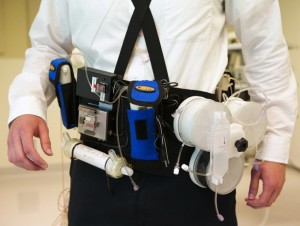
Victor Gura, an associate clinical professor of medicine at the David Geffen School of Medicine, UCLA, and his colleagues have developed and are testing the first wearable dialysis machine.
Patients who need dialysis must currently go to clinics and hospitals, where they are hooked up to a machine and spend as much as four hours sitting while the machine removes waste and excess water from blood. It can be a life-saving or life-extending, procedure but degrades a patient’s quality of life.
Gura and his team have come up with WAK (Wearable Artificial Kidney), a belt device that patients wear all the time. It cleans and filters blood continuously, just as a healthy kidney would. The prototype is not something you can wear discreetly under an extra-large t-shirt. But in a small trial, patients were easily able to perform daily tasks, including showering, and even eating foods that are normally off limits for dialysis users. The device weighs about 10 pounds and is battery powered.
The FDA approved WAK for the first U.S. trial in early 2014, and the device is being produced by Blood Purification Technologies, which has been raising money through the nonprofit Wearable Artificial Kidney Foundation for further trials.